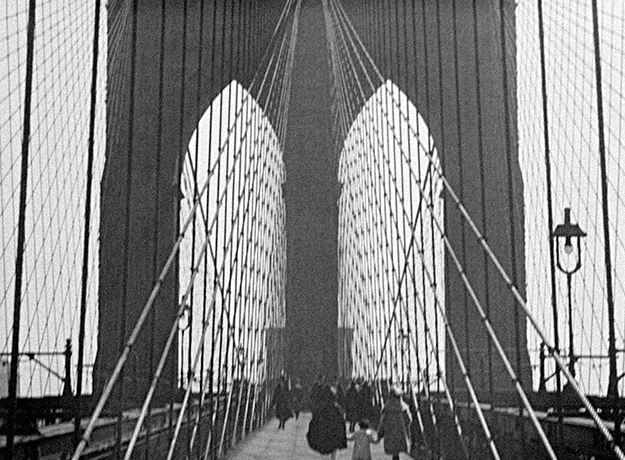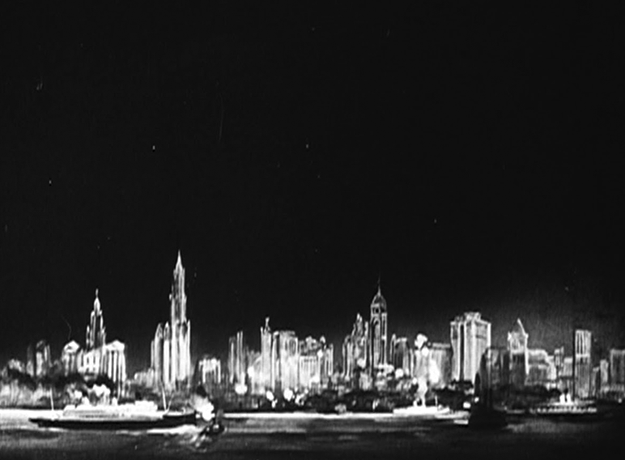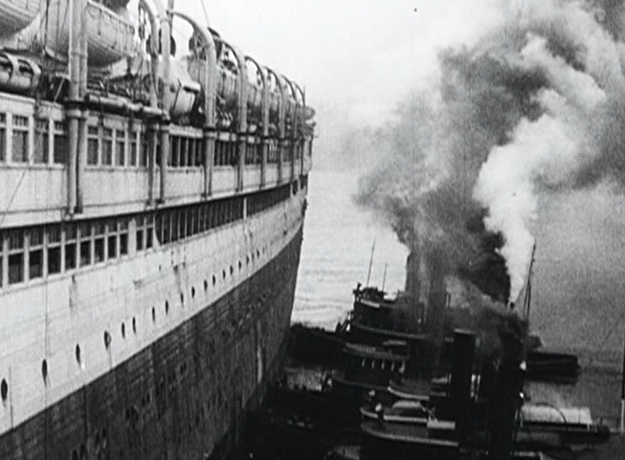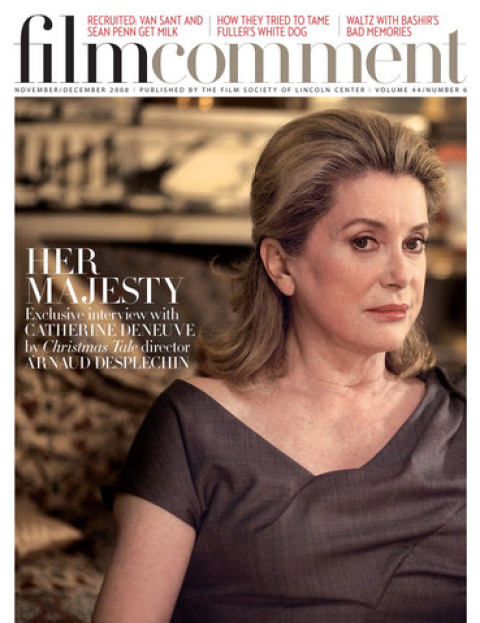
CHRIS CHANG: What was the creative spark that led to two years, six cultural institutions, and one Bruce Posner restoring 11 minutes of film?
In 2005, after putting together the Unseen Cinema film and DVD retrospectives, Manhatta was in constant demand. This was most evident with the art museums that wanted to present it alongside paintings and photographs by masters such as O’Keefe, Stieglitz, etc. In 2006, I was invited to a National Gallery of Art “thank you” dinner for people who loaned work to the “Charles Sheeler: Across Media” exhibition. It was the first time I had seen Manhatta in context with “still” artworks. Sheeler’s art (photos, drawings, and paintings) is quite precise in its execution—very exact and complex. The Unseen Cinema version of Manhatta was displayed on a large monitor. Although the film’s size was nothing near what it would have been in a movie theater, it still dwarfed the Sheeler work surrounding it. Unfortunately, the film, as it had been handed down to us, was a mess. It shook, was very soft, contrasty and dirty, just terrible in relation to the pristine still images on exhibit. Right then and there, I decided that not only was a full 2K digital restoration needed but that it would prove whether or not a vintage film such as Manhatta could benefit from the process.
Were there others sharing your enthusiasm?
Sad to say, I couldn’t get anyone at that dinner to fork over the dough. Believe me, I tried. But a year and a half later, I was able to convince a rather large consortium of preservation partners* that this was a worthwhile experiment to attempt—even if it failed. There are few, if any, examples in cinema history of a film of such widespread influence, that had exerted said influence from a deteriorated projection copy.
What was the process for wrangling support?
The key was the production of a sample reel. Due to its state of extreme damage, the film was pretty much a wild card to companies performing digital restoration. I decided to have a test made by each potential vendor. They were given the same unrestored 2K scan data, and then went to work on a one-minute section. I stayed out of the way. The three tests were then edited into a sample reel that demonstrated what the project might accomplish. It showed the previously available versions of the film, the source material to be used, and a healthy selection of before-and-after examples. I shopped the reel around to organizations that would (or should) have been interested in such a radical procedure.
What was so radical?
The price tag—and the fact that there weren’t any guarantees that this would actually work! No one had ever digitally restored an early Twenties film that was so poorly processed and printed and subsequently ruined by laboratories involved with its preservation.
And the job went to . . .
After vetting the tests I decided that Lowry Digital, then operating as DTS Digital Cinema in Burbank, could handle the job in a manner fitting the material.
Even I’ve heard of them.
It was impossible not to be seduced by their client list that included all of Disney’s animation, the Lucas and Spielberg epics, and the James Bond films. This initial reaction almost proved to be the undoing of the project. Lowry’s big-name clients obviously took priority over a small antique art film submitted by a ragtag coalition of film archives. This “Hollywood shuffle” kept my life unbalanced in that I could never tell when a more illustrious, hell-bent-on-deadline project would delay work on Manhatta. The list of higher-profile projects we were up against included: Benjamin Button, U23D, The Robe, Rashomon, etc. More often than not, I would enter the Baselite editing suite to see Lowry colorist Rick Taylor working on a studio project, such as John Carpenter’s Assault on Precinct 13—a film, as it happens, I had worked on 30 years earlier at the Florida Optical House. Back then, I “pan and scanned” it from 35mm Scope to 16mm flat prints for USO distribution. Now, Lowry was bringing it back to its full 35mm glory in 2.55 aspect Scope!
So your 10-minute film was up against some pretty big guns.
That had a positive side: the project dragged on so long that Manhatta was able to benefit from new R&D created for better-funded ventures. The Rashomon restoration, for example, spurred Lowry to develop more advanced warp-stabilization software. The process was applied to 20 scenes of Manhatta, and what a difference that made! When warped imagery and the alignment between frames are simultaneously corrected, which is what this new technique managed, the final image reads sharper. A Lowry technician mentioned to me that several years earlier, on Bambi, this same type of correction had to be applied by hand, one frame at a time. Now, the process is plotted from the beginning to the end of a scene and automatically registered. One project’s problem begets a solution for the next—and so on.

I am sensing a conversion moment.
I finally crossed over to the “dark side” as follows: one day while working at Lowry, I had the epiphany. Finally I realized that weave and jitter, dirt and scratches, luminance shifts and flicker were unnecessary distractions to the film experience. I could let go of these sentimentally imbued artifacts and wholeheartedly embrace the full range of digital possibility. In effect, with a wave of the digital wand, these once favored anomalies could be wiped away forever. 2K and larger 4K data files surpass the 35mm film frame’s ability to contain information necessary to recreate clarity and color and can be totally controlled down to each and every pixel, millions of them per frame. It remains a matter of how much ingenuity can be applied to a particular image and, of course, how much money.
This is all a bit humbling when considering Strand and Sheelers’ original $1,600 production tab.
Actually, we don’t know what they paid for the film. The $1,600 figure is always misquoted as the price of the 35mm Debrie L’Interview Type E camera that Sheeler purchased previous to making Manhatta. I recently discovered that the camera actually cost 1,600 French francs. Somehow the dollars and francs got confused in the retelling of the story. Sadly there’s very little documentary evidence on the making of Manhatta. Some letters between Strand and Stieglitz provide most of the story. Many years later, throughout the Fifties and Sixties, Strand offered his recollections filtered through interviews. But most of that was 50 years after the fact. Sheeler never really said a peep. Since they were both quite poor at the time, I am sure they did not spend that much money on the making of the film. What is astounding is that we spent so much money restoring it.
Convincing people that that was the right kind of thing to do must have been a challenge.
Early on in the project, someone suggested it would probably be cheaper to just go out and shoot the film from scratch. Today’s digital-restoration tools are incredible, and getting better every day, but they are outrageously expensive. Beyond that basic fact, the real problem, at least as I see it, is the amount of new material one generates. Strand and Sheeler completed the film and had two small rolls of 35mm film: the picture negative and the title roll. If they needed a print, they had to splice the titles on to the film. Today, I have so much material, from the 2K DPX files, down through various HDCAMSR videotapes, to the final 35mm film negatives and prints. There is literally thousands of dollars of material to store and to preserve beyond the new film negative.
I don’t want to go all Bazinian, but, to your eye, what is the purest way to experience the restoration?
That involves a discussion most of your readers can’t begin to appreciate without access to the full range of technology. To see Manhatta at a 2K facility, such as Lowry Digital, where the individual digital frames can be projected on a theater-size screen, is one hell of an experience. It’s simultaneously amazing and sobering. Right now, there can’t be more than several dozen set-ups around the world where that’s even possible. This is not the same as a theatrical release of a film in “digital cinema”—which is actually a slightly lower resolution experience. That said, each format and viewing environment have their pluses and minuses. Viewing an HDCAMSR videotape on a 40” studio monitor is one experience, a standard-definition DVD on a video projector another, a 35mm print on a large screen yet another, and so on. And then there’s the iPod! (Remember their ad campaign: “How about a little video?”) The boundaries are so confused and unverifiable; it’s hard to say what is the purest.
And in case the conventional die-hards aren’t getting the message?
Conventional film projection is an antiquated 20th-century form. Film, for all of its special qualities, is dead in the water. At some point, film stock will cease being manufactured, and that will be that. Individual film prints—no matter in what state—will be treasured for all of those qualities that we now admire. The ironic twist will be that the old prints will be seen as just that, old prints dating from an earlier era. You can already see this in Manhatta, or any of the silent and classic films currently released for DVD by companies such as Criterion, Flicker Alley, Lobster, etc. The standards for DVD production have evolved to such an extent that we now expect clean, sharp, and stable images, and are less than satisfied if too much visual damage or noise remains apparent. Many of these films now show the patina of restoration, that is, the look of automated-image processing accomplished via today’s digital tools. The bar has been raised, and we as viewers have sublimated the new technologies without even acknowledging how they have changed the viewing experience. It’s not a good or bad thing, just the new improved thing.
Any tips for budding restoration geeks?
It’s essential for anyone entering the field to understand that one problem resolved uncovers a new set of problems previously hidden. The digital reality is that what you repair will probably create new problems. These are the often referred to as “digital artifacts.” Simply put, once a film is scanned, it’s no longer made up of grain, but of pixels that look and act, if lucky, like grain. As the hours of digital processing accumulate, the potential for pixels going “totally pixel” becomes exponentially greater if not inevitable. So my job, as producer, was to make sure the pixels retained some semblance of film grain in the final output. There are a lot of tricks to make this work, but the bottom line is that these are now pixels, not film grain. Thus the illusion is maintained—and isn’t that the basis for all filmmaking? [A good overview of Posner’s restoration motivations can be found in a 2002 Senses of Cinema interview.]

When the technology improves, will you restore Manhatta again?
No. This was a one-time experience. To accomplish what we did took an awful lot out of everyone and everything involved—including the 1949 b/w dupe negative from which we sourced the restoration. If there’s room for further work, it’s now beyond the capabilities of current digital technology. I say this while acknowledging several different disciplines. But the techno-wiz in me says, Yes! Let’s do it again with the latest newest gizmo. I have already received some exciting offers! But the conservator and art historian sees that we have already imposed a lot of speculative decisions upon the existing imagery. One key example: it is quite clear from looking at the 1949 negative, and from reports dating back to the 1927 London screening, that the film’s so-called “teetering” is most probably due to hand-cranking during the original cinematography. The dupe negative also exhibits a lot of shaking derived from subsequent duplication of the film, first in the Twenties, and then later in 1949. Each time the film was copied, more and more movements were compounded. Anyone would be hard-pressed to say what shaking should be removed and to what extent. This goes on and on, like a virtual hall of mirrors, until it’s impossible to separate what was intended and what was not.
What would the original filmmakers have thought?
I firmly believe that Strand and Sheeler would have embraced digital tools with great zeal. They’re both great craftsmen who understood their respective mediums and drew upon an understanding of process to make great artistic statements. Strand would often manipulate his negatives and prints extensively. He would hand-render them with thousands of little pencil marks to cover up or highlight an aspect of his compositions. Sheeler is well known for his use of one media, such as photography, to create a new and similar work in another, such as painting or drawing. He used frame enlargements from Manhatta to make photographs, watercolors, and paintings exhibited before the film had its public premiere in 1921. I think that in a very short period of time, both artists mastered the aesthetics of filmmaking even though they may have screwed up some simple technical aspects—such as the hand-cranking. But the film, even in its pre-restored form, has been able to communicate to millions of viewers. Hopefully the digitally restored version will bring it to audiences in a form closer to that which the filmmakers had originally intended. I know that when I view the new Manhatta I see a very beautiful film. I think Strand and Sheeler would have approved.
Bruce Posner would like to thank: for their unstinting support, financial or otherwise, I would be an ungrateful fool if I didn’t acknowledge Steven Higgins and Peter Williamson at The Museum of Modern Art, Charlie Brock, Peggy Parsons, and Sarah Greenough at the National Gallery of Art, Mark-Paul Meyer at Nederlands Filmmuseum, everyone at The Library of Congress, Naomi Rosenblum (a great photography historian and close personal friend of Paul Strand), and, last but not least, my long-time preservation associates Jonas Mekas and Robert Haller at Anthology Film Archives. The folks at Lowry Digital are too many to list, but for the record: “Thanks John, Mike, Amy, Ryan, Sarah, Rick, Robin, and Alan.”
*The six Manhatta digital restoration and preservation partners include Anthology Film Archives; British Film Institute; The Library of Congress; The Museum of Modern Art; National Gallery of Art; and Nederlands Filmmuseum. Additional support was provided by The Aperture Foundation; Chace Audio Productions; Center for Creative Photography, University of Arizona; Cineric, Inc.; Du Art Film and Video; Filmmakers Showcase; Film Technology Company; Department of Photographs, The J. Paul Getty Museum; Department of Photography, The Museum of Modern Art; Lane Collection; Lobster Films; Museum of Fine Arts, Boston; Paul Strand Trust for the Benefit of Virginia Stevens; Post Logic Studios; Technicolor Digital Services; Turner Classic Movies; Unseen Cinema: Early American Avant-Garde Film 1893-1941; and YCM Laboratories.








